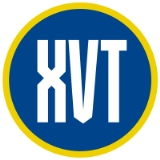
XVT
Encyclopedia
- XvT is also an abbreviation for the X-Wing vs. TIE Fighter video game
- xvt is also an X Window SystemX Window SystemThe X window system is a computer software system and network protocol that provides a basis for graphical user interfaces and rich input device capability for networked computers...
terminal emulatorTerminal emulatorA terminal emulator, terminal application, term, or tty for short, is a program that emulates a video terminal within some other display architecture....
created by John Bovey of the University of Kent at CanterburyUniversity of KentThe University of Kent, previously the University of Kent at Canterbury, is a public research university based in Kent, United Kingdom...
.
XVT is a software development
Software development
Software development is the development of a software product...
environment for building cross-platform
Cross-platform
In computing, cross-platform, or multi-platform, is an attribute conferred to computer software or computing methods and concepts that are implemented and inter-operate on multiple computer platforms...
GUI
Graphical user interface
In computing, a graphical user interface is a type of user interface that allows users to interact with electronic devices with images rather than text commands. GUIs can be used in computers, hand-held devices such as MP3 players, portable media players or gaming devices, household appliances and...
applications in C
C (programming language)
C is a general-purpose computer programming language developed between 1969 and 1973 by Dennis Ritchie at the Bell Telephone Laboratories for use with the Unix operating system....
or C++
C++
C++ is a statically typed, free-form, multi-paradigm, compiled, general-purpose programming language. It is regarded as an intermediate-level language, as it comprises a combination of both high-level and low-level language features. It was developed by Bjarne Stroustrup starting in 1979 at Bell...
. XVT allows developers to graphically lay out an application's GUI, and provides cross-platform libraries to aid development.
XVT currently supports the Microsoft Windows
Microsoft Windows
Microsoft Windows is a series of operating systems produced by Microsoft.Microsoft introduced an operating environment named Windows on November 20, 1985 as an add-on to MS-DOS in response to the growing interest in graphical user interfaces . Microsoft Windows came to dominate the world's personal...
, Linux
Linux
Linux is a Unix-like computer operating system assembled under the model of free and open source software development and distribution. The defining component of any Linux system is the Linux kernel, an operating system kernel first released October 5, 1991 by Linus Torvalds...
, Mac OS X
Mac OS X
Mac OS X is a series of Unix-based operating systems and graphical user interfaces developed, marketed, and sold by Apple Inc. Since 2002, has been included with all new Macintosh computer systems...
, Solaris
Solaris Operating System
Solaris is a Unix operating system originally developed by Sun Microsystems. It superseded their earlier SunOS in 1993. Oracle Solaris, as it is now known, has been owned by Oracle Corporation since Oracle's acquisition of Sun in January 2010....
, HP-UX
HP-UX
HP-UX is Hewlett-Packard's proprietary implementation of the Unix operating system, based on UNIX System V and first released in 1984...
, and AIX
AIX operating system
AIX AIX AIX (Advanced Interactive eXecutive, pronounced "a i ex" is a series of proprietary Unix operating systems developed and sold by IBM for several of its computer platforms...
platforms. With XVT, applications can be designed and developed once and then subsequently compiled on any of these platforms. XVT also allows programs to be built to run across a network, meaning that the processing would take place on a local host but the user interface would take place on a remote host.
XVT has been in development since 1989 and has provided a cross-platform software development toolkit for the majority of that time. XVT software is utilized in a number of mission-critical production sites and applications.
Their approach is not as a widget replacement look-alike set, but acts more like a universal API translator. XVT is an "abstraction layer" that removes the developer from being concerned with which OS the application will run on. When your application is compiled, the XVT API points to the native controls/widgets for the OS on which you are compiling your code. This matters to OS user-purists, who can be very fussy when the views "aren't quite right." It also allows you to build applications that will adapt whatever user themes the OS allows users to set.
There are other uses of this product beyond cross platform development (though it does this well). As a CASE tool, a non-programmer business analyst can actually lay out all the user interfaces, review them with end users and subject matter experts in a RAD-like (Rapid Application Development
Rapid application development
Rapid application development is a software development methodology that uses minimal planning in favor of rapid prototyping. The "planning" of software developed using RAD is interleaved with writing the software itself...
) requirements capture by functional review, and then the XVT architect tool will deliver the C or C++ (ANSI-compliant) code. This would take a bit of familiarity with a compiler and the layout tools, but it would allow programmers to be relieved of coding GUI and focus their work on the business logic, event handling, etc.
Version 5.8 release notes indicate that the product developers are concerned with ease of use issues. GTK+ is not released yet, nor Mac Cocoa (though these are due out this year?). It does work with Vista, but as all Vista apps are discovering, the help file format needs a viewer from Microsoft for win32 that Microsoft chose not to include. This hurts backwards compatibility with existing help files (though it is fairly simple to find and download the Microsoft .hlp viewer).
XVT was originally developed by Advanced Programming Institute in Boulder Co., a company founded by Marc Rochkind. The company changed its name to XVT when that product became the main company effort. The XVT product was purchased by Providence Software Solutions, Inc. in 2001.

